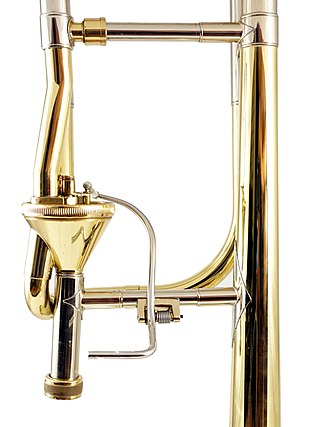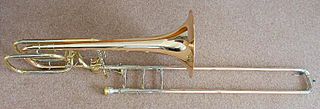Related Research Articles

A brass instrument is a musical instrument that produces sound by sympathetic vibration of air in a tubular resonator in sympathy with the vibration of the player's lips. Brass instruments are also called labrosones or labrophones, from Latin and Greek elements meaning 'lip' and 'sound'.

The euphonium is a medium-sized, 3 or 4-valve, often compensating, conical-bore, tenor-voiced brass instrument that derives its name from the Ancient Greek word εὔφωνος euphōnos, meaning "well-sounding" or "sweet-voiced". The euphonium is a valved instrument. Nearly all current models have piston valves, though some models with rotary valves do exist.
In music, a glissando is a glide from one pitch to another. It is an Italianized musical term derived from the French glisser, "to glide". In some contexts, it is equivalent to portamento, which is a continuous, seamless glide between notes. In other contexts, it refers to discrete, stepped glides across notes, such as on a piano. Some terms that are similar or equivalent in some contexts are slide, sweepbend, smear, rip, lip, plop, or falling hail. On wind instruments, a scoop is a glissando ascending to the onset of a note achieved entirely with the embouchure, except on instruments that have a slide.

The trombone is a musical instrument in the brass family. As with all brass instruments, sound is produced when the player's vibrating lips cause the air column inside the instrument to vibrate. Nearly all trombones use a telescoping slide mechanism to alter the pitch instead of the valves used by other brass instruments. The valve trombone is an exception, using three valves similar to those on a trumpet, and the superbone has valves and a slide.

The trumpet is a brass instrument commonly used in classical and jazz ensembles. The trumpet group ranges from the piccolo trumpet—with the highest register in the brass family—to the bass trumpet, pitched one octave below the standard B♭ or C trumpet.

The valve trombone is a brass instrument in the trombone family that has a set of valves to vary the pitch instead of a slide. Although it has been built in sizes from alto to contrabass, it is the tenor valve trombone pitched in B♭ which has seen the most widespread use. The most common valve trombone has three piston valves, and plays just like a trumpet but an octave lower. They are built in either short or long form.

The serpent is a low-pitched early wind instrument in the brass family developed in the Renaissance era. It has a trombone-like mouthpiece, with tone holes and fingering like a woodwind instrument. It is named for its long, conical bore bent into a snakelike shape, and unlike most brass instruments is made from wood with an outer covering of leather. A distant ancestor of the tuba, the serpent is related to the cornett and was used for bass parts from the 17th to the early 19th centuries.

The cimbasso is a low brass instrument that covers the same range as a tuba or contrabass trombone. First appearing in Italy in the early 19th century as an upright serpent, the term cimbasso came to denote several instruments that could play the lowest brass part in 19th century Italian opera orchestras. The modern cimbasso design, first appearing as the trombone basso Verdi in the 1880s, has four to six rotary valves, a forward-facing bell, and a predominantly cylindrical bore. These features lend its sound to the bass of the trombone family rather than the tuba, and its valves allow for more agility than a contrabass trombone. Like the modern contrabass trombone, it is most often pitched in F, although models are occasionally made in E♭ and low C or B♭.

The superbone is a hybrid tenor trombone in B♭ that has both a slide like a regular trombone and a set of valves like a valve trombone.

The axial flow valve, or Thayer valve, is a brass instrument valve design patented in 1978 by Orla Ed Thayer. Designed with assistance from Zigmant Kanstul, it was originally intended to replace the traditional rotary valve on the French horn, but instead revolutionized the design of trombone valve attachments. Combined with open-wrap tubing, it eliminates the impedance caused by tight tubing bends, improving the airflow through the instrument and the open "feel" perceived by the player.

The bass trombone is the bass instrument in the trombone family of brass instruments. Modern instruments are pitched in the same B♭ as the tenor trombone but with a larger bore, bell and mouthpiece to facilitate low register playing, and usually two valves to fill in the missing range immediately above the pedal tones.

The ophicleide is a family of conical-bore keyed brass instruments invented in early 19th-century France to extend the keyed bugle into the alto, bass and contrabass ranges. Of these, the bass ophicleide in C or B♭ took root over the course of the 19th century in military bands and as the bass of orchestral brass sections throughout Western Europe, replacing the serpent and its later upright derivatives. By the end of the 19th century however, it had been largely superseded by early forms of the modern tuba, developed from valved ophicleides.

The alto trombone is the alto member of the trombone family of brass instruments, smaller than the tenor trombone. It is almost always pitched in E♭ a fourth higher than the tenor, although examples pitched in F are occasionally found. The alto trombone was commonly used from the 16th to the 18th centuries in church music to strengthen the alto voice, particularly in the Mass. Alto trombone parts are usually notated in alto clef.

The Firebird is a type of trumpet with the standard three valves and the addition of a trombone-style slide. It was invented by Maynard Ferguson and Larry Ramirez and remains an exceptionally rare, specialist instrument. They were occasionally produced by Holton.

The contrabass trombone is the lowest-pitched instrument in the trombone family of brass instruments. While modern instruments are pitched in 12 ft F with a single slide, the first practical contrabass trombones appeared in the mid-19th century built in 18′ B♭ an octave below the tenor trombone with a double slide. German opera composer Richard Wagner notably called for this instrument in his Der Ring des Nibelungen opera cycle in the 1870s, and contrabass trombone has since appeared occasionally in large orchestral works without becoming a permanent member of the modern orchestra.

The subcontrabass tuba is a rare instrument of the tuba family built an octave or more below the modern contrabass tuba. Only a very small number of these large novelty instruments have ever been built. Most are pitched in 36’ BBB♭ an octave lower than the BB♭ contrabass tuba, its fundamental B♭-1 corresponding to a practically inaudible 15 Hz.

The soprano trombone is the soprano instrument in the trombone family of brass instruments, pitched in B♭ an octave above the tenor trombone. As the bore, bell and mouthpiece are similar to the B♭ trumpet, it tends to be played by trumpet players rather than trombonists. Compared to tenor, bass, or even uncommon alto, the soprano is a rare trombone. Seldom used in classical music since its first known appearance in 1677, it survived principally in the trombone ensembles of Moravian Church music. During the 20th century some soprano trombones—dubbed slide cornets—were made as novelties or for use by jazz trumpet players including Louis Armstrong and Dizzy Gillespie. A small number of contemporary proponents of the instrument include jazz artists Wycliffe Gordon and Christian Scott, and classical trumpeter Torbjörn Hultmark, who advocates for its use as an instrument for young children to learn the trombone.
Christian Friedrich Sattler (1778–1842) was a brass instrument maker and inventor in Leipzig, Germany. In 1821, Sattler became renowned for two inventions: the chromatic valve trumpet which applied three valves to the natural trumpet to provide a fully chromatic range for the first time, and the Tenorbaßposaune. A tenor trombone in B♭ with the larger bore and mouthpiece of a bass trombone in F, he improved it further in 1839 by inventing the quartventil, a valve attachment to lower the instrument a fourth into F to provide the lower range available to the bass trombone. In Sattler's workshop in the Querstraße in Leipzig he built "signal horns and chromatic valve horns", new inventions at the time. He also built his own design of trombones with a wider bell flare and larger bore, that were widely adopted by players and other instrument makers, notably Czech maker Červený. Today, they are still known as "Leipzig model" or "German" trombones.

Václav František Červený was a Czech brass instrument maker and inventor. He became the principal manufacturer in Austria-Hungary.
Christopher Monk was an English musicologist, early music specialist, performer, and musical instrument maker. He was prominent in the mid-20th century revival of interest in Renaissance period wind instruments, particularly the cornett and serpent, and was involved in the historically informed performance movement.
References
- ↑ "Valide". Grove Music Online (8th ed.). Oxford University Press. 2001. doi:10.1093/gmo/9781561592630.article.J463100. ISBN 978-1-56159-263-0.
- ↑ "Really Doubling in Brass". Popular Science . 146 (5): 81. May 1946.
- ↑ Yeo 2021, p. 161, "valide".
- ↑ Herbert 2006, p. 200.
- ↑ Yeo 2021, p. 143, "superbone".